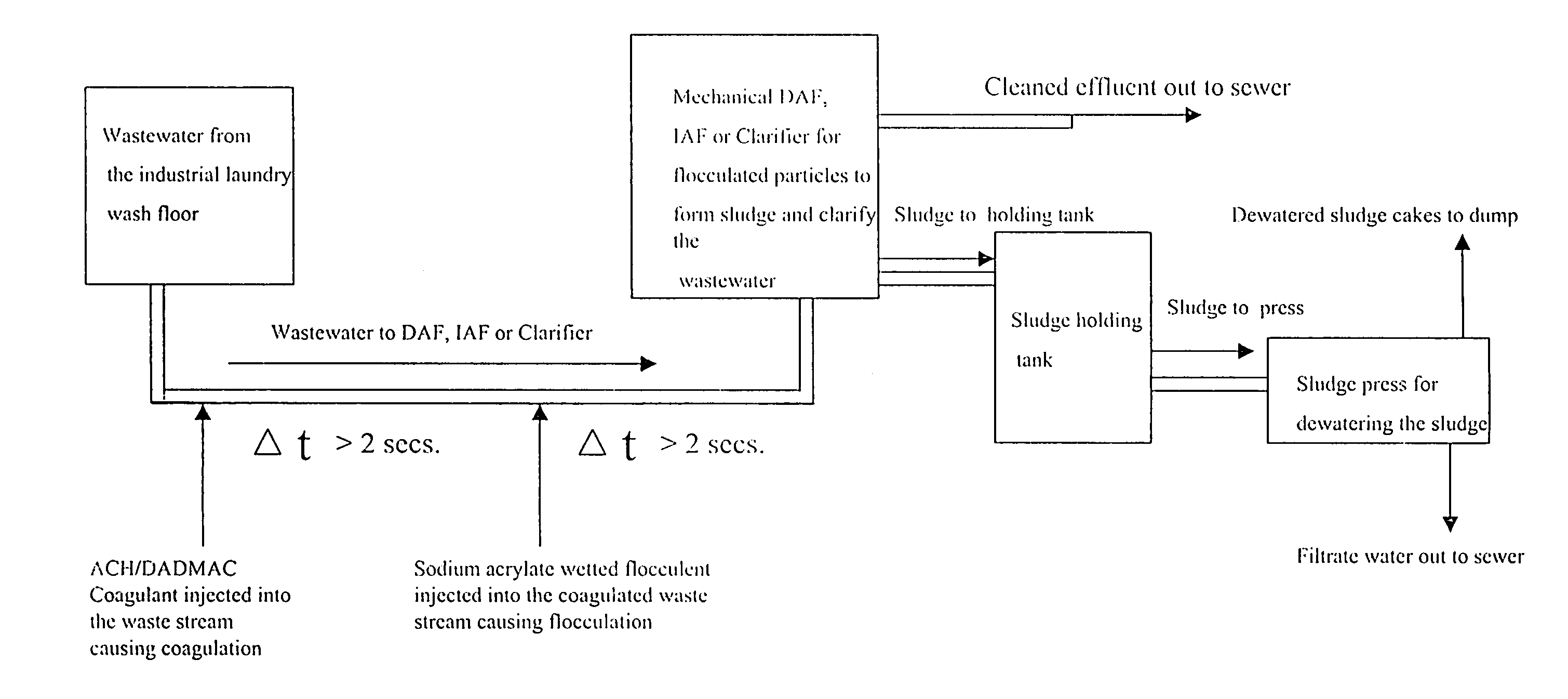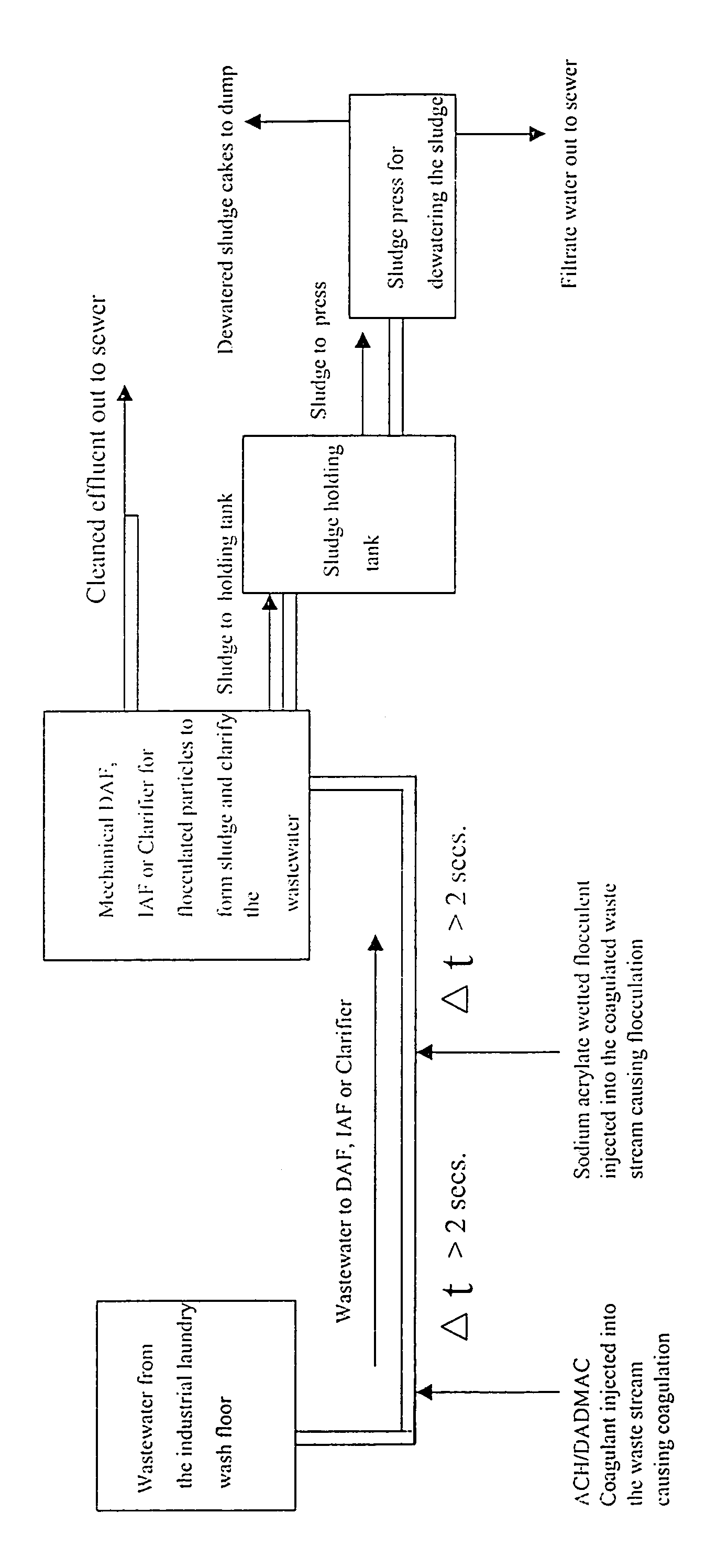Method of clarifying industrial laundry wastewater using cationic dispersion polymers and anionic flocculent polymers
a technology of industrial laundry wastewater and anionic flocculent polymer, which is applied in water treatment multi-stage treatment, water/sewage multi-stage treatment, separation process, etc. it can solve the problems of more costly disposal of industrial laundry wastewater, and achieve the elimination of additional in-stream and downstream additives, the effect of cleaning the wastewater and reducing the generation of sludg
- Summary
- Abstract
- Description
- Claims
- Application Information
AI Technical Summary
Benefits of technology
Problems solved by technology
Method used
Image
Examples
example one
[0032]Laundry plant #1 with a daily average water usage of 110,000 gallons per day with 50% of the input product being shop towels, mats, ink wipers and other heavy soils was producing 1.1% of their daily wastewater as liquid sludge. The prior existing program being used for industrial pretreatment was a poly(diallydimethylammonium chloride) solution with a dose rate of 200–500 ppm coupled with the use of a six percent bentonite clay fed at the rate of 600 ppm, residence time for each chemical was 15–20 seconds at 125 gpm flow. This created coagulated particles that were then flocculated with a 0.2% polyacrylate flocculent at 6–8 ppm to produce particles able to be floated through mechanical means. The plate and frame press produced dewatered sludge cakes amounting to 135 cubic feet per day.
[0033]The method of this invention was used to replace the then existing program with a dose rate of 200–400 ppm of coagulant using a mix time of approximately 20 seconds, and the application of ...
example two
[0035]A newly installed dissolved air flotation wastewater system at Plant #2 began utilization of the methods of this invention for chemical treatment of the wastewater at start-up. The volume of water produced by the facility was approximately 70,000 gallons per day and the product mix comprised mostly of heavily grease-laden linen from the food industry. The methods of the invention were applied at 300–600 ppm using a mix time of approximately 15 seconds of coagulant and 25–45 ppm of flocculent using a mix time of approximately 30 seconds, resulting in floc able to be floated through mechanical means, with a resulting sludge production of 0.3% of the influent flow. Since the application of the invention, all required effluent parameters have been compliant with EPA requirements.
[0036]Treatment in accord with this invention resulted in an influent reduction of 421 ppm of biochemical oxygen demand (BOD) to <5.3 ppm (method EPA 405.1), and 360 ppm to <5.0 ppm oil and grease (method ...
example three
[0039]An industrial laundry with an average flow of 80,000 gallons per day treated the wastewater with a pDADMAC coagulant coupled with an aluminum salt (200–400 ppm) injected prior to the transfer pump and bentonite clay (600–900 ppm) injected 15 seconds later and sodium acrylate flocculent (7 ppm) 15 seconds down stream. Water was non compliant with a reading of eight (8) on a standard turbidity wedge. Sludge production for the facility was 1100 gallons per day. Filter cakes were not forming inside of the press which necessitated hauling away the liquid sludge.
[0040]After replacement of the above-described program in accord with this invention at 250 ppm of coagulant being injected prior to the transfer pump and 30 ppm of flocculent being injected at the former clay injection point, sludge was reduced to 350 gallons per day. The plant became compliant with 35+ on a standard turbidity wedge. This new process formed sludge cakes by the press amounting to 7 cubic feet per day, and su...
PUM
| Property | Measurement | Unit |
|---|---|---|
| weight percent | aaaaa | aaaaa |
| weight percent | aaaaa | aaaaa |
| weight percent | aaaaa | aaaaa |
Abstract
Description
Claims
Application Information
 Login to View More
Login to View More - R&D
- Intellectual Property
- Life Sciences
- Materials
- Tech Scout
- Unparalleled Data Quality
- Higher Quality Content
- 60% Fewer Hallucinations
Browse by: Latest US Patents, China's latest patents, Technical Efficacy Thesaurus, Application Domain, Technology Topic, Popular Technical Reports.
© 2025 PatSnap. All rights reserved.Legal|Privacy policy|Modern Slavery Act Transparency Statement|Sitemap|About US| Contact US: help@patsnap.com


